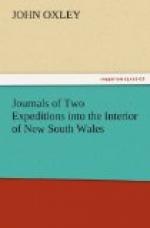side exceeding one thousand two hundred feet, the
width at the edges about two hundred yards. From
thence it descends as before described until all sight
of it is lost, from the vast elevation of the rocky
hills which it divides and runs through. The
different points of this deep glen seem as if they
would fit into the opposite fissures which form the
smaller glens alternately on either side. The
whole is indeed a grand natural spectacle, and is an
indubitable mark of the vast convulsions which this
country must at one period have undergone. The
rocks are all slate, the upper romanae of which are
of a light brown colour, rotten, and easily separated.
Nearer the base or surface of the water they are of
a dark blue, and of a firmer texture. The waters
are quite discoloured, owing to the nature of the bed
over which they run, the soluble particles of coal
among the slate tinging them a dark brown. This
fine fall is not more than five miles below the place
where we crossed the river on the 9th instant, and
we were doubtless prevented from hearing the noise
of the waters, by the numerous smaller falls in the
vicinity. This most magnificent fall and the
river itself were respectively named Bathurst and Apsley,
in honour of the Noble Secretary of State for the
colonies. Although a week had elapsed in effecting
the passage of this river, we could not consider it
as entirely lost, especially as it enabled us to ascertain
that its direction was to the coast; and we hoped
that the nature of the country would permit us to
fix its embouchure.
September 16.—The weather for some days
past has been very unseasonable, cold and tempestuous,
with frequent heavy and continued showers of rain:
this remarkable coldness of temperature in such a latitude
(31 degrees,) I cannot but attribute to the considerable
elevation of the country above the sea, being certainly
between four and five thousand feet. We proceeded
to the south-east during this day’s journey,
on purpose to avoid the broken land in the vicinity
of the river. It was good travelling though hilly:
the soil, for the most part, a poor clay; and the
timber not so good or large as usual. There was
however much good land, particularly in the valleys,
through every one of which a stream of water took
its course to the river. At twelve miles, we halted
on the banks of a considerable and rapid stream watering
an extensive and wide valley. The many waters
which fall into Apsley River must very considerably
increase its magnitude; and I am in hopes after it
has cleared this mountainous tract and we again fall
in with it, that we shall find it a useful as well
as fine stream. The river on which we encamped
was named Croker’s River, in honour of the First
Secretary of the Admiralty.




